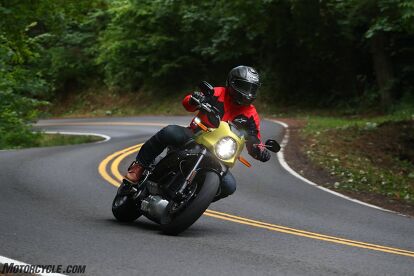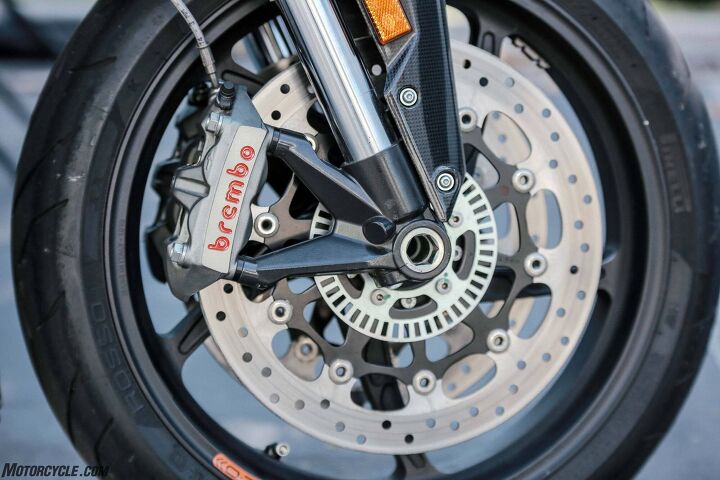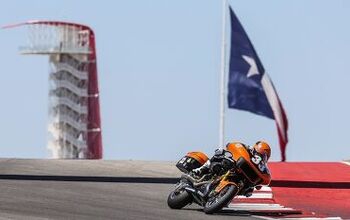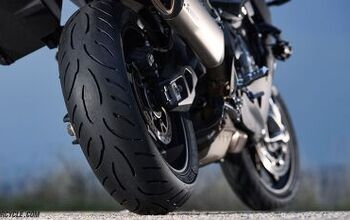2020 Electric Motorcycle Spec Shootout

(7/30: Updated to include gear reduction ratios, final drive ratios, and calculated motor torque at the wheel).
They say the first auto race started the moment the second car was made, and the same holds true in motorcycling, too. With the introduction of the 2020 Harley-Davidson Livewire, this marks the first time a major manufacturer – actually, the major-ist manufacturer (yes, new word) – has entered the electric motorcycle space in large numbers. And while they are a fraction of the size of Harley, Energica and Zero have the benefit of a years-long head start in the e-bike biz.
Now, after riding the Livewire, we’re left to wonder – how exactly does it stand up to the competition? Specifically, we’re looking at the Energica Eva and the new Zero SR/F. We’re working on getting all three machines in the flesh to settle the score, but in the meantime, we’ve compiled some specs on all the bikes. Fancy a little bench racing, anyone?
Comparing Base Models
Before getting hung up in the many different permutations the Energica and Zero are offered in, let’s start with a three-way comparison of the base versions of each bike. At $18,995, the standard version of the Zero SR/F is the least expensive offering here, followed closely by the $21,656 Energica Eva without any options. There’s only one version of the Livewire available, with its price tag reading $29,799.
No matter which trim package or options you choose, all three come with a standard battery and motor. The Eva’s battery produces a max of 13.4 kWh, with a nominal rating of 11.7 kWh – the lowest in this group. However, battery capacity isn’t the whole story, as the Eva’s oil-cooled motor is rated at 145 hp (107 kW) and a massive 148 lb-ft (200 Nm) of torque!
Move next to the Zero, and the SR/F’s lithium-ion battery is rated at 14.4 kWh max, 12.6 kWh nominal. Meanwhile, its air-cooled motor puts out considerably less power at 110 hp (82 kW), but its 140 lb-ft (190 Nm) nearly matches the Eva’s.
Lastly, there’s the Livewire, with its max battery capacity of 15.5 kWh and nominal rating of 13.6 kWh. Harley-Davidson states the Livewire’s makes 105 hp (78 kW) and 86 lb-ft (116 Nm). Interestingly, the Livewire is the only one of the trio cooling the motor with water.
Horsepower and torque numbers are one thing, but how it’s applied to the ground is another. This is where things get interesting. Looking strictly at the numbers, the Livewire’s 86 lb-ft. of torque would seem highly outclassed in this field, but factor in its massive 3.24 gear reduction and 3.00 final drive ratio, and the Livewire’s calculated torque to the wheel jumps to 835.9 lb-ft. The Energica’s 1.82 reduction and 2.75 final drive land its 148 lb-ft of motor torque at 741.5 lb-ft at the wheel, while the direct-drive Zero only has its final drive ratio of 4.50 to amplify its 140 lb-ft. to 630 lb-ft.
Being base models, the costs go up from here with different hardware options, which will be explained next.
Range
With battery and motor setups established, we move on to the business of depleting the batteries and how long that takes. Of course, like an internal combustion engine, mileage will vary depending on your riding habits. This is even more significant on electrics, as heavy right hands can make an electric’s range plummet fast. Still, various standardized tests for city, highway, and combined mileage at least give us a (very) rough guess as to how far one can go on a tank full of electrons.
Energica isn’t very helpful in its provided materials, simply saying the Eva can get “up to 120” miles. With so little to work with, we can only assume those would be the most boring, mind-numbing 120 miles anyone would ever ride on a motorcycle, as you’d have to ride so slow to get that far.
Meanwhile Harley and Zero are more forthcoming with relevant information, with the former claiming 146/70/95 (city/highway/combined) figures for the Livewire according to MIC standardized tests, and Zero claiming 161/82/109 numbers according to SAE J2982 standards.
Having spent time with both bikes recently, the 95-mile and 109-mile combined figures, respectively, seem optimistic but doable under normal riding/commuting. To get there would likely require more conservative ride modes, smart application of regenerative braking, and a gentle throttle hand – all things the average commuter could get used to without too much adaptation. Expect those numbers to come closer to the highway figures (or lower) once you reach the fun roads and crank up the power and/or turn down the regen.
This is where we reach the first price upgrade with the Zero, although the exact amount is yet unknown as of press time. Like Zero’s S and DS models, Zero will offer a Power Tank accessory for the SR/F at a yet undisclosed price, offering up to 223 miles (claimed) of city range. Considering the S/DS Power Tanks cost nearly $3000, it’s reasonable to expect the SR/F Tank to have a similar price tag.
Charging
Obviously, when you run out of battery, you have to recharge. Here all three companies have taken a slightly different approach to their charge strategies. There’s no surprise all three have Level 1 provisions to plug into the wall outlet in your home, but the differences come when you want to speed things up. Both the Eva and SR/F accept Level 2 charging, but the Eva is equipped to accept up to 24 kW of DC Fast Charge, allowing a completely drained battery to reach 85% State of Charge (SoC) in as little as 20 minutes.
The Zero is not compatible with DCFC, but its approach to recharging, in addition to the included 3 kW on-board charger, is to allow the customer to upgrade to the Premium model which adds an additional 3 kW charger and $2000 to the price. Another $2300 gets you another 6 kW of charging, for a total capability of 12 kW, which completely replenishes a dead battery in one hour. This also brings the total price to $23,295.
Harley skips Level 2 charging entirely, making the Livewire DC Fast Charge-ready, which brings the battery from 0%-80% in 40 minutes. Wait another 20 minutes and it’s fully topped off. Since the vast majority of public charging stations out in the wild are Level 2 stations, we wonder why Harley made this choice.
Though they are increasing in number, Level 3 DCFC stations are still relatively scarce, which means the challenge for all three machines is finding suitable charging stations that can provide enough electricity.
Other Interesting Bits and Bobs
Not long ago e-bikes didn’t feature much in the way of rider aids. An odd thing considering the amount of torque being channeled through the rear tire. Now, all three motorcycles come equipped with safety features like ABS and traction control, though the Livewire and SR/F are equipped with IMUs (Inertial Measurement Units), upping the ante further with Cornering-ABS and lean-sensitive traction control. Drag torque slip control (basically like a slipper clutch on a ICE motorcycle) is found on the Harley and Zero, while the Livewire also features rear wheel lift mitigation.
When it comes to the more traditional pieces found on a motorcycle – suspension and brakes – all three stack up relatively evenly. Showa provides fork and shock bits for both the Livewire and SR/F. The Big Piston-Separate Function Fork is found on each, while the shocks are slightly different. Each are tuned to the respective manufacturer’s specifications.
The Livewire gets the smallest rotors here; two 300mm floating rotors are squeezed by 4-piston monoblock radial-mount calipers. In contrast, the Zero sees twin 320mm floating discs clamped by J-Juan radial 4-piston calipers. Besting them all, however, is the Eva’s 330mm discs and Brembo radial-mount calipers. The bigger discs make sense since the Energica is also the heaviest bike here by a significant chunk: 615 lbs compared to 549 lbs for the Livewire and 485 lbs for the SR/F (which climbs to 498 for the Premium model). All three have regenerative braking abilities to also help slow them down.
Being the Italian performance company that it is, the price starts to jump with the Energica when it comes to suspension and wheels. As it comes standard, the Eva sees Marzocchi and Bitubo provide fully-adjustable fork and shock, respectively. Cast aluminum wheels are also standard. If that won’t cut it, an extra $2000 will get you OZ forged wheels, and $3300 on top of that will swap the Marzocchi/Bitubo combo for Öhlins pieces. Those two options alone bring the Eva’s price to nearly $27,000.
And The Winner Is…
Ha! It’s much too soon to be making that call, but at least these specs laid out side-by-side below help portray a clearer picture of what each motorcycle is capable of. But what do you want to know about this trio? Tell us in the comments and we’ll do our best to answer once we get all three in the flesh.
Energica Eva 107 | Harley-Davidson Livewire | Zero SR/F | |
|---|---|---|---|
| MSRP | $21,656 – $30,443 | $29,799 | $18,995 – $23,295 |
| Motor Type | Permanent magnet AC, oil cooled | Permanent magnet, water cooled | Interior permanent magnet AC, air-cooled, 900 Amp, 3-phase AC controller |
| Battery Type | Lithium polymer | Lithium-ion 12.8V, 24 Wh, 120 A | Lithium-ion |
| Battery Capacity | 13.4 kWh (max), 11.7 kWh (nominal) | 15.5 kWh (max), 13.6 kWh (nominal) | 14.4 kWh (max), 12.6 kWh (nominal) |
| Power (claimed) | 145 hp (107 kW) | 105 hp (78 kW) | 110 hp (82 kW) |
| Torque (claimed) | 148 lb.-ft. (200 Nm) | 86 lb-ft. (116 Nm) | 140 lb-ft. (190 Nm) |
| Charge Type | On-board 3 kW, J1772 and IEC 62196-2 inlet; level 2 and DCFC compatible | On-board 1400 W SAE J1772 Combo Inlet (CCS1)/IEC 62196 Combo Inlet (CCS2); level 3 DCFC compatible | On-board 3 kW (Premium model: 6 kW), J1772 inlet, level 2 compatible, configurable to 3 kW, 6 kW, 9 kW, or 12 kW |
| On-Board Charge Time | Level 1 (AC wall charger): 8+ hours Level 2: 3.5 hours (0-100% SoC) Level 3 24 kW DCFC: 20 mins (0-85% SoC) | Level 1 (AC wall charger): 12.5 hours Level 2: NA Level 3 DCFC: 40 mins (0-80% SoC), 60 mins (0-100% SoC) | Level 1 (AC wall charger): 8+ hours Level 2: (6 kW) 2 hours (0-95% SoC), (12 kW) 60 mins (0-100% SoC) |
| Internal Gear Reduction | 1.82:1 | 3.24:1 | 1.00:1 |
| Final Drive | 525 O-Ring Chain (16/44). 2.75 final drive ratio | Belt. 3.00 final drive ratio | Belt. 4.50 final drive ratio |
| Overall Gear Ratio | 5.01 | 9.72 | 4.50 |
| Calculated Motor Torque at Wheel | 741.0 lb-ft. | 835.9 lb-ft. | 630.0 lb-ft. |
| Range (City/Highway/Combined) | Up to 120 miles | 146/70/95 (according to MIC standardized test) | 161/82/109 (according to SAE J2982 standards) |
| Rider Aids | ABS, traction control (6-level), cruise control, 4 ride modes w/4 regen levels (including off) | Cornering ABS, lean-sensitive traction control, rear-wheel lift mitigation, drag torque slip control, 7 ride modes (4 preset, 3 custom) w/4 regen levels (including off) | Cornering ABS, traction control, drag torque control, 14 ride modes (4 preset, 10 custom) |
| Frame | Steel tubular trellis | Modular cast aluminum | Steel tubular trellis |
| Front Suspension | Marzocchi 43mm, Adjustable Rebound and Compression Damping, Spring Preload (Öhlins available as an upgrade) | Showa 43mm Inverted Separate Function Forks – Big Piston (SFF-BP), fully adjustable, 4.5 inches travel | Showa 43 mm Big Piston Separate Function forks, with adjustable spring preload, compression and rebound damping, 4.72 in travel |
| Rear Suspension | Bitubo Rear Mono Shock Adjustable Rebound, Spring Preload (Öhlins available as an upgrade) | Showa Balance Free Rear Cushion Lite (BFRC-lite), fully adjustable, 4.5 inches travel | Showa 40 mm piston, piggy-back reservoir shock with adjustable spring preload, compression and rebound damping, 5.51 in travel |
| Front Wheel/Tire | Cast aluminum, 3.5” x 17”, Pirelli Diablo Rosso III 120/70 ZR17 | Cast aluminum, 3.5” x 17”, Michelin Scorcher “Sport” 120/70 ZR17 | Cast aluminum, 3.50 x 17, Pirelli Diablo Rosso III 120/70 ZR17 |
| Rear Wheel/Tire | Cast Aluminum: 5.5” x 17”, Pirelli Diablo Rosso III 180/55 ZR17 | Cast Aluminum, 5.5” x 17”, Michelin Scorcher “Sport” 180/55 ZR17 | Cast aluminum, 5.5” x 17”, Pirelli Diablo Rosso III 180/55 ZR17 |
| Front Brake | Brembo, 330mm double floating discs, 4-piston radial caliper w/regenerative braking | 300mm dual floating rotor, 4-piston monoblock radial-mount; ABS and regenerative braking | Dual 320mm floating discs, J-Juan radial 4-piston calipers, ABS and regenerative braking |
| Rear Brake | Brembo, 240mm Single Disc, 2-Piston Caliper w/Regenerative Braking | 260mm floating rotor, dual-piston caliper; ABS and regenerative braking | 240mm disc, J-Juan single-piston caliper, ABS and regenerative braking |
| Rake/Trail | 24.0°/3.9 in. | 24.5°/4.3 in. | 24.5°/3.7 in. |
| Wheelbase | 58.9 in. | 58.7 in. | 57.1 in. |
| Seat Height | 31.3 in. | 30.7 in. | 31.0 in. |
| Curb Weight | 615 lbs | 549 lbs | 485 lbs (standard)/498 lbs (premium) |
| Warranty | On vehicle 2 years – on battery 3 years/31,000 miles | Battery: 5 years, unlimited miles | Motorcycle: 2 years Battery: 5 years/unlimited miles |

Troy's been riding motorcycles and writing about them since 2006, getting his start at Rider Magazine. From there, he moved to Sport Rider Magazine before finally landing at Motorcycle.com in 2011. A lifelong gearhead who didn't fully immerse himself in motorcycles until his teenage years, Troy's interests have always been in technology, performance, and going fast. Naturally, racing was the perfect avenue to combine all three. Troy has been racing nearly as long as he's been riding and has competed at the AMA national level. He's also won multiple club races throughout the country, culminating in a Utah Sport Bike Association championship in 2011. He has been invited as a guest instructor for the Yamaha Champions Riding School, and when he's not out riding, he's either wrenching on bikes or watching MotoGP.
More by Troy Siahaan





















































Comments
Join the conversation
Why wasn't the Polaris (Brahmo) compared with these other 3 e- bikes? It has been out about as long as Zero.. Likewise, the new Evoke looks to be a possible leader of the pack... I appreciate the article, but you folks need more insight..
Let us get this electric motorcycle thing straight right now. Please (if you are old enough) remember the Radio Shack Bomar Brain, it was a hand held calculator with square root for $99 (you can buy the same thing at Dollar Tree for $1). Hold that idea and add this idea, the Motorola Brick was a cell phone for us computer sales guys back in the 1980s and cost over $1200 with no bundled time allotment.
Now, tell me where you can get parts for one or both of them and who do you know will repair them..... NOBODY!!!!!! Who soups them up..... NOBODY.
Now if you found a Matchtless G80 in Uncle Joe's garage in running order, could you get someone to tune it up for you? Yep, because it is not full of electronic modules that no longer exist. For the most part you could get parts from the UK,USA and a few other places at a small premium and be riding inside a week.
Just how does that relate to a 2014 Zero needing a bistemoral-fluating-stiblulator module. huh? Who is going to split a SS retaining ring on a rare earth magnet rotor for an upgrade.... you?
I am not a nostalgia nut, just a guy who runs the wheels off a motorcycle and especially one I can easily fix or modify running on gasoline.... anywhere. I have worked diligently with good rewards in the computer world and done my share of mods, worked with electric motors & controllers, inductors, and various battery systems.
At the end of the day I would certainly rather hear the tink tink tink of the exhaust pipe cooling down than a nondescript voice "your battery needs charge".
Thanks for a fine article on the top electric bikes, maybe I could do a hybrid but a pure electric with massive acceleration would be cute for a while, then the old urge to hear the pipe sing... ah what oily glory.